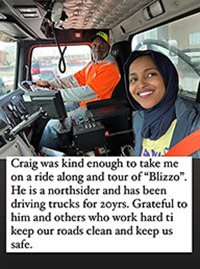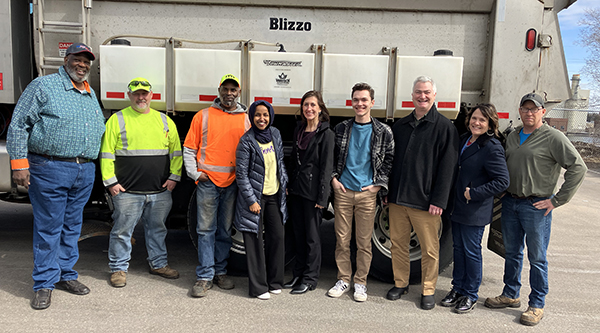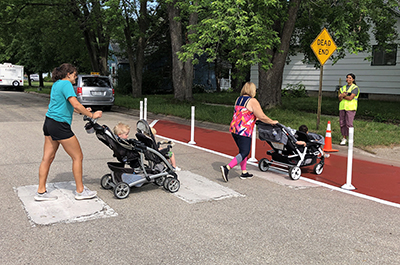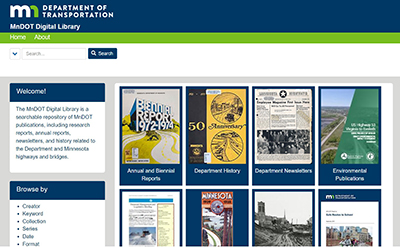 |
|

|
 |
TABLE of CONTENTS
 |
Camden Truck Station crew highlights maintenance operations for congresswoman |
By Doug Mack

Rep. Omar gave her Instagram followers a taste of the plowing process as she road along with Craig Johnson, Camden Truck Station. Image via Rep. Omarís Instagram |
Just weeks after MnDOT leadership took a ride-along with plow drivers, Rep. Ilhan Omar got her own up-close view of the plowing process during a visit to the Camden truck station in North Minneapolis on March 25.
Touring the facility with Commissioner Nancy Daubenberger, Rep. Omar learned about plowing (including a ride-along and a demonstration of a tow plow), tunnel washing, the MnDOT hiring process and other topics.
“We toured the shop and explained to her what each piece of equipment does,” said Dewayne Jones, Metro District maintenance manager. “We shared with her that the Camden shop has many bridges to clean even after the snow is gone and she seemed excited to hear this.”
Rep. Omar shared videos of the experience, including the ride-along, on her Instagram and Twitter pages, expressing her gratitude to MnDOT plow drivers for their hard work to “keep our roads clean and keep us safe.” On both platforms, she also gave a nod to Blizzo, the Camden station’s newly named plow.

Dewayne Jones, Metro District; Jason Garrett, Metro District, Craig Johnson, Metro District; Rep. Ilhan Omar, Commissioner Nancy Daubenberger, Jacob Daubenberger, Nancy's son; Serge Phillips, Government Affairs; Jean Heyer, district director for Rep. Omar; and Anthony Erickson, Metro District; stood in front of the new Blizzo plow. Submitted photo |
|
| |
|

|
 |
TABLE of CONTENTS
 |
New study examines gender equity in transportation |
By Hally Turner, Office of Transportation System Management

Pedestrians cross the road at a study site in La Crescent, Minn. Photo courtesy of Office of Transportation System Management |
As part of MnDOT’s Advancing Transportation Equity Initiative, the agency recently collaborated with the University of Minnesota to study the role of gender identity in transportation. The study examined the ways in which gender affects travel needs, experiences and subjective well-being.
The authors used mixed research methods including a literature review, data analysis and travel diaries. Participants across the state completed 14-day travel diaries, including questions about travel (such as trip type, mode of transportation and time of day), gender identity, share of household tasks and transportation barriers.
The results highlight various ways that gender identity intersects with other social identities like race, family type, employment and life stage.
“Females in general shared more household supporting tasks and relied more on household vehicles for travel than males. However, within the gender group of females, Black females were more likely to use public transit compared to females of other races,” the authors wrote in the study. “Another example was that females with kids were less likely to have out-of-home activities and trips than males during weekday afternoons. However, within the gender group of females, Hispanic and Black females were very likely to have late-afternoon activities.”
Additional findings include:
- Females completed more household tasks than males even when they teleworked from home. As a result, females made more trips than males and nonbinary people, typically relying on a personal household vehicle.
- Nonbinary people had the lowest social well-being outcomes of all gender groups, due to many negative experiences in their daily activities and trips.
Taken together, the findings showed that gender identity does affect a user’s transportation experience.
The study concluded that to advance transportation equity, policymakers and practitioners need to consider the complexities of gender and social identities throughout transportation. The suggested recommendations include:
- Adopting gender-inclusive language in project communications.
- Completing qualitative research on the net negative transportation experiences among nonbinary people.
- Developing relationships with community-based organizations to collect feedback from hard-to-reach populations.
More information about the study can be found on MnDOT’s Advancing Transportation Equity website or by contacting Erika Shepard. |
| |
|

|
 |
TABLE of CONTENTS
 |
Staffing updates: Ryan Gaug named Aeronautics director |
By Doug Mack
Ryan Gaug has been named the director of the Office of Aeronautics, effective March 29. Gaug has worked with MnDOT since 2008 and had previously served as interim Aeronautics director since spring 2022. He has also served in as the office’s as assistant office director and planning director, along with past roles in the Office of Transportation Systems Management and in the Metro District.
Prior to joining MnDOT, Gaug worked as a congressional aide in Washington, D.C. and district offices.
Ryan has an undergraduate degree in political science from Wittenberg University and a master’s degree in Urban and Regional Planning from the University of Minnesota’s Humphrey School. |
| |
|

|
 |
TABLE of CONTENTS
|
MnDOT Library launches digital library |
By Julie Swiler, Office of Research & Innovation

Screenshot of digital library landing page.
|
The MnDOT Library recently got a request for a copy of Minnesota Standard Specifications for Highway Construction from 1938. It might seem obscure, but the request was easy to fulfill because a digitized version of the manual was readily available in the newly launched MnDOT Digital Library.
The MnDOT Digital Library is a public repository of publications produced by MnDOT, including documents originally created in a digital format and those that have been digitized. It features 12 collections that include research reports, State Aid publications, annual reports, photographs, state highways maps, photographs and historical publications.
Each item in the digital library has a persistent link, which means that it won’t break, making access to this information reliable into the future.
“The digital library serves as a central location for MnDOT publications available to MnDOT staff and the public. It’s a user friendly interface with powerful search capabilities,” said Sheila Hatchell, MnDOT Library director. “It’s easy to find information searching by keyword, creator, collection date or format.”
MnDOT Library staff developed the digital library to address the reality that more and more publications are published digitally. Once COVID-19 hit, the demand to receive information digitally grew exponentially.
“The digital library solves the problem of how to provide access to the library’s digital items and it creates an online source of MnDOT print publications that we’ve digitized,” said Marilee Tuite, MnDOT librarian and project manager for the digital library development.
Scanning thousands of pages of items – some dating back as far as 1917 – was a two-year team effort between MnDOT Library staff and Printing and Electronic Media Services.
To date, there are more than 2,247 items in the digital library, with plans to make thousands more available.
“It is an ever-evolving repository of information,” said Hatchell.
If you have items for the digital library, please contact MnDOT Library through Ask a Librarian. |
| |
|

|
 |
TABLE of CONTENTS
|
Social media moderation: Balancing free speech and community guidelines |
By Siobhan Gordon, social media coordinator, Office of Communications and Public Engagement

Siobhan Gordon, MnDOT's social media coordinator. Submitted photo
|
Social media has become a powerful tool for communication, allowing people to connect with each other, share ideas and express themselves. For more than a decade, MnDOT communicators statewide have successfully used social media to deliver timely transportation-related information and connect with members of the public.
MnDOT’s social media channels have grown considerably in just the past two years alone (February 2021 to February 2023):
- Facebook — +42,141 followers (43% growth)
- Twitter — +16,522 followers (31% growth)
- Instagram — +3,883 followers (52% growth)
- LinkedIn — +4,701 followers (31% growth)
With the rise in social media usage comes a need for clearly defined social media moderation guidelines for anyone who chooses to communicate on or with official MnDOT social media accounts. While we have had guidelines in place for some time now, they continually evolve as the social media world itself changes. In April 2022, we updated MnDOT’s Social Media Use Policy; most recently, we revised our Social Media Community Rules.
MnDOT's official social media accounts are limited public forums, which means that we can determine what can and cannot be discussed on these platforms. However, we must strictly adhere to First Amendment rights, so it is rare for us to remove any content from our social media accounts at MnDOT.
Per our Social Media Community Rules, we do not allow content that:
- Is off topic;
- Is obscene, sexually explicit, defamatory, threatening or directed at any legally protected class of persons under federal and state laws;
- Contains personally identifiable information, including, but not limited to home address or phone number;
- Contains solicitations, advertisements, or spam (including items posted repeatedly). This includes promotion or endorsement of any non-state government entity or any advertisement of a business or product;
- Promotes or opposes any person campaigning for election to a political office;
- Incites or promotes violence or encourages illegal activity;
- Contains information that reasonably could compromise individual or public safety; or
- Infringes on copyrights or trademarks.
We understand the importance of social media for MnDOT in connecting with our community, and we strive to create a safe and respectful online environment for all users. Our Social Media Community Rules are designed to ensure that our social media accounts are a place for constructive dialogue and engagement while respecting the rights of all individuals. We encourage our followers to engage with us and share their thoughts and ideas while keeping in mind the guidelines we have established.
For more information about MnDOT’s various social media accounts, visit the main social media page on the agency’s website. If you have any questions, comments or concerns, please reach out to me at siobhan.gordon@state.mn.us. |
 |
|
|
|



